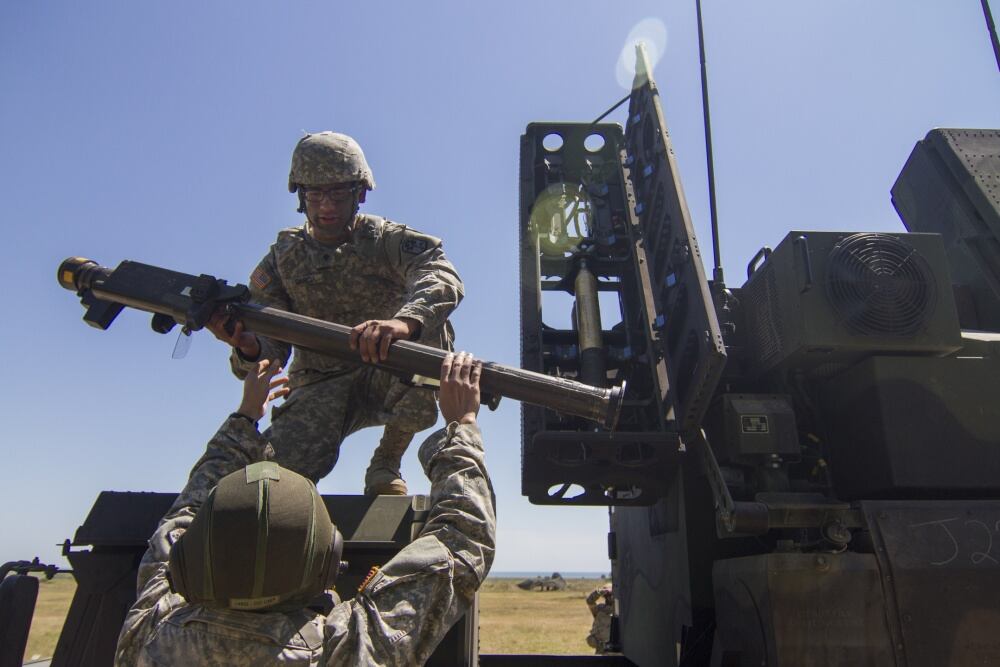WASHINGTON — The U.S. Army is getting close to greenlighting Stinger missiles that are more lethal against enemy drones following a string of successful tests last month.
The Cruise Missile Defense Systems Project Office, or CMDS, demonstrated a new proximity warhead capability on a Stinger missile during flight testing at Eglin Air Force Base, Florida, over a three-week period in August.
The first two weeks of the test event were focused on characterizing the capability of the proximity warhead against static drone targets. In the final week, the proximity fuze-equipped Stingers went up against nine free-flying unmanned aircraft systems ranging from small to roughly 1,000-pound variants — about the size of a Shadow UAS — according to Wayne Leonard, the product lead for Stinger-based systems at CMDS.
The Stinger missiles were fired from man-portable air-defense systems and Avenger launcher systems to show they can be safely fired from both.
RELATED

The two systems are being used as a temporary capability-gap filler for short-range air defense in Europe as the Army works to bring on an interim SHORAD capability that can keep up with the maneuver force.
Stinger missiles will be a part of that interim SHORAD solution, too.
Previous versions of the Stinger missile use a hit-to-kill capability to take out targets, which requires extreme accuracy. Drone targets, with unpredictable flight paths, make it even harder for a Stinger missile to make contact. A proximity warhead capability allows for a Stinger to get within close range of a target, then detonate an explosive to neutralize targets that are within close range of the missile.
Now that the critical testing has wrapped up for the Stinger missile with the proximity fuze warhead, the Army will make a determination on an urgent materiel release. That decision is expected in February 2019 after Army Test and Evaluation Command releases its report, according to Leonard.
Getting more lethal Stingers approved for urgent fielding was no small feat, but it was done in just a year following receipt of a new surge of funds to move forward on the project, Col. Chuck Worshim, project manager for CMDS with the Army’s Program Executive Office Missiles and Space, told Defense News in a Sept. 7 interview.
Just a year ago, there was no long-term plan to improve the Stinger missile, he said. In 2014, the Army received some funding to broadly find ways to make the missile better, but the money only covered some of the initial development of a proximity fuze capability, Worshim said. Then when the funding ran out, the effort stopped.
But with a new set of urgent modernization priorities outlined by Army Chief of Staff Gen. Mark Milley last year where SHORAD and counter-UAS — among other efforts — have risen to the top, the project office received enough funding in July 2017 to finally make the proximity fuze Stinger missile a reality.
The new Stinger missile “will bring an increased lethality,” Worshim said, and that will get “after those small UAS, drones, that are being proliferated across the world right now and wreaking havoc.”
The Army’s fast-paced effort to finish development and qualify the new more-lethal Stinger missile was made possible through the other transaction authority process, which helped the service bypass part of the initial drawn-out contracting timeline to rapidly prototype and move forward, Worshim said.
Once the Army approves the Stinger missile for urgent materiel release, that will trigger a five-year Service Life Extension Program, or SLEP, where the service will take 5,000 existing Stinger missiles in its inventory over a five-year period and add the proximity warhead as well as replace an older flight motor and a gas generator cartridge to address obsolescence issues, Leonard said.
The budget to upgrade the 5,000 missiles across five years is roughly $270 million.
This will not just increase the Stinger’s lethality, Worshim said, but also inject another 10 years of life into the missiles.
The SLEP program will be carried out at McAlester Army Ammunition Plant in Oklahoma.
The service expects that within three months of the approval of the urgent materiel release, it will have roughly 500 missiles to deploy wherever the Army deems necessary, according to Worshim.
Jen Judson is an award-winning journalist covering land warfare for Defense News. She has also worked for Politico and Inside Defense. She holds a Master of Science degree in journalism from Boston University and a Bachelor of Arts degree from Kenyon College.







